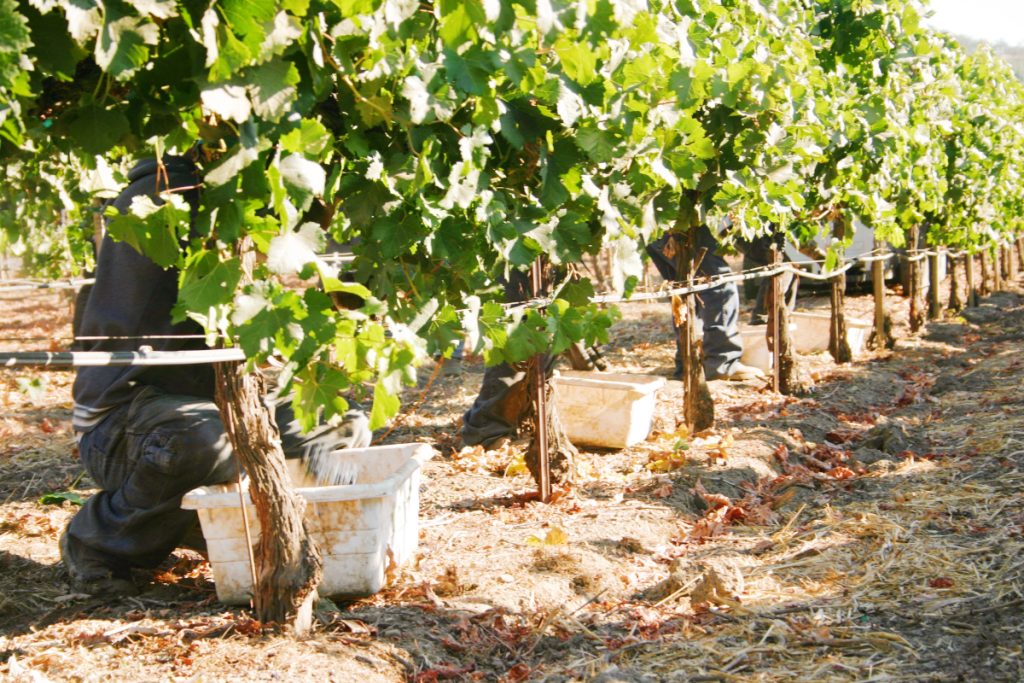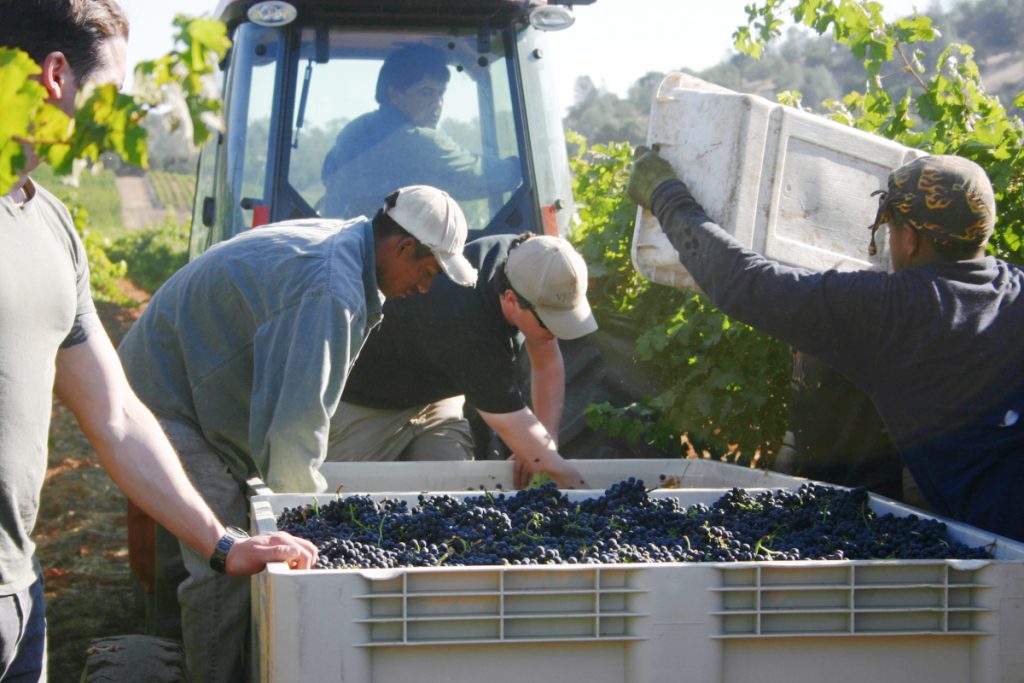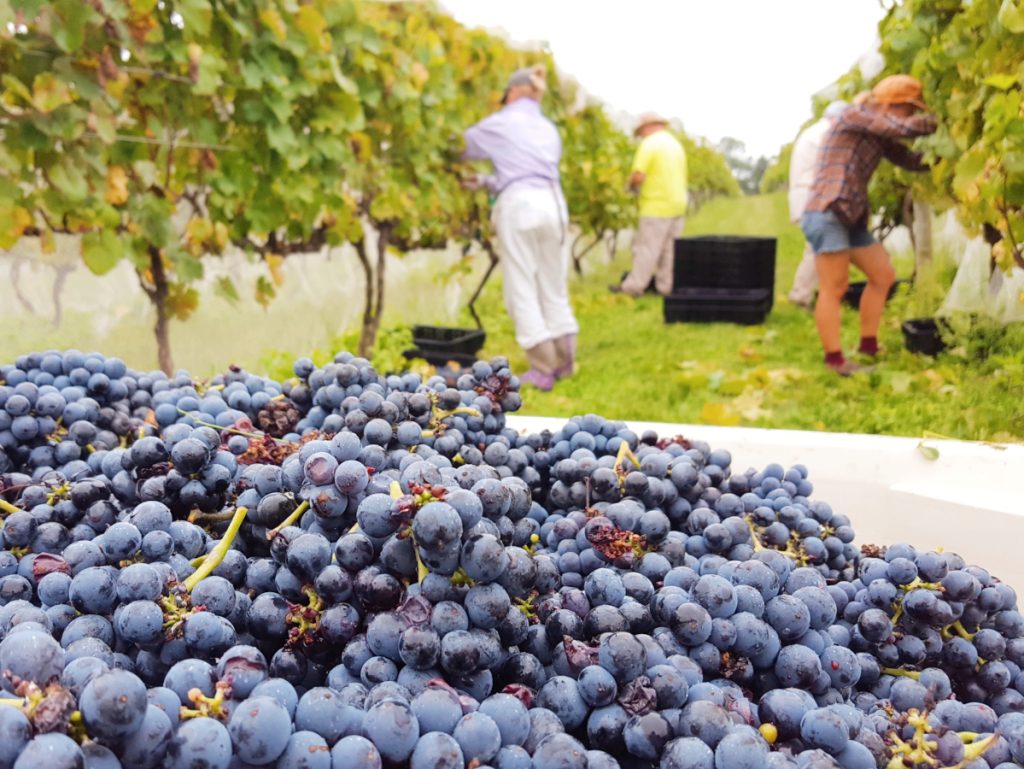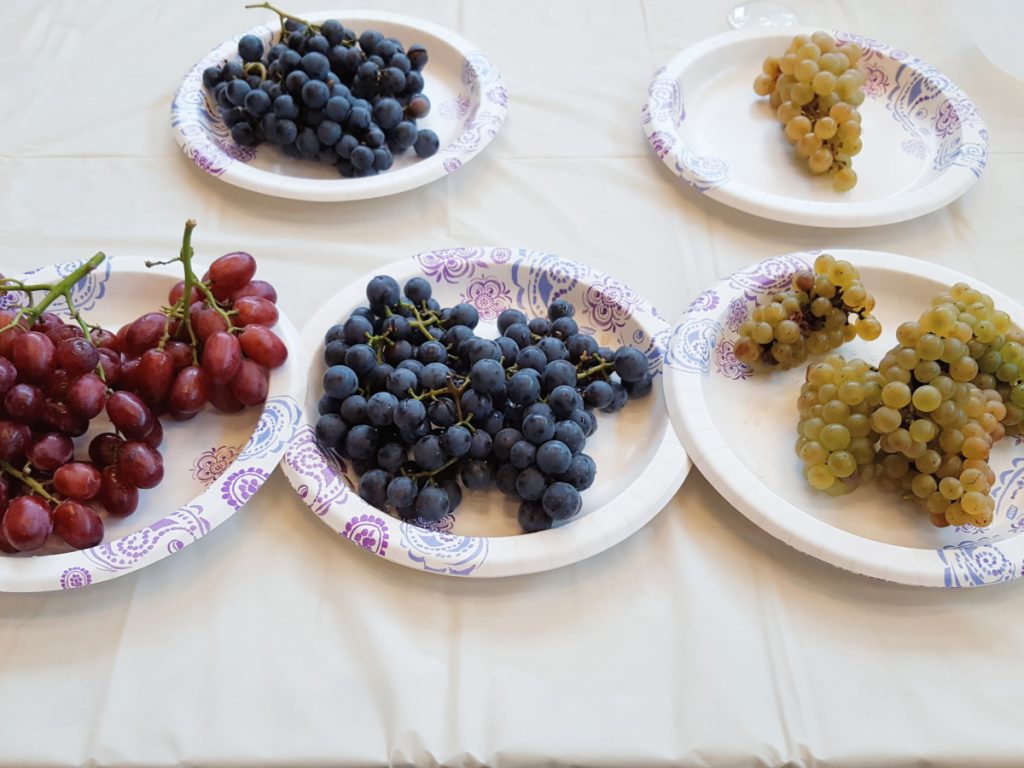
Photo by Denise M. Gardner
The month of September is a hectic one in the wine industry. Or, I should say, it’s hectic for those wine industries in the Northern Hemisphere.
September tends to be the month when various wine grape growing regions are harvesting wine grapes. Some regions may be finishing up their annual harvest while others are just beginning.
In the wine industry, you’ll hear various stories or rumors that decorate the harvest season. Some wineries will “cheers” the pending vintage by opening bottles of sparkling wine. Others will pour a bottle of last year’s vintage wine over the first lot of incoming grapes at the start of harvest season. And still others celebrate at the close of harvest with a big party, yummy food, and good (you guessed it) wines.
While it may sound like a really fun time, it’s also a period of time packed with a lot of work!

Photo by: Denise M. Gardner
What goes on during the wine grape harvest?
For many in the U.S., harvest is a tricky time of year. Growers and winemakers wait patiently as they regularly monitor grapes reaching their premium ripeness levels. Each wine grape variety will ripen at a different pace and during a different time of the harvest season. We often differentiate these by “early ripening” varieties and “late ripening” varieties. Wine grape varieties that are “early ripening” come in during the first few weeks of harvest, while wine grape varieties that are “late ripening” come into the crush pad during the last few weeks of harvest.
After veraison, when the berries start to noticeably change in color, growers and winemakers focus on sugar concentration, acid concentration and content, seed ripeness, and, potentially, flavor ripeness. The goal is to get uniform color maturity, minimizing any instance of green berries, while also getting adequate (but not too much) acid, high enough sugar, and ripe flavors. The more uniform and mature the color, especially with regards to red wine grape varieties, the more red pigments can get extracted during fermentation. This translates into darker, deeper red wine colors.
In contrast, the more sugar in the berries means the more potential alcohol concentration by the time fermentation is done. For many varieties, growers and winemakers aim to reach at least 21 Brix sugar content. This translates into at least 11.5% alcohol by the time fermentation is complete. Some wine grape varieties will never reach this sugar concentration. For example, many Muscat varieties, Niagara and Concord varieties, and even varieties like Cayuga or Edelweiss may only reach about 12 – 17 Brix. This is because these varieties either start to deteriorate after these maximum Brix levels, are prime targets for destruction by weather events or birds, or overripen creating noticeable, undesirable flavors in the fruit.
Monitoring tannins is not a ubiquitous process, but many winemakers will take the time to look at seed and skin tannins while grapes are still hanging on the vine. As the tannins ripen, the seeds may change from a green color to a dark brown color. However, the taste of grape skins and seeds also changes. As these components mature on the vine, it translates into softer, less aggressive, and less drying tannins when tasted.
Acid is monitored for two reasons: stability and taste perception. The higher the acid in the fruit, the more acidic the wine will taste after fermentation is complete. However, wines also require enough acid to maintain their longevity and freshness. Thus, acid monitoring is a delicate balance, which takes years for winemakers and growers to fully know what to expect from a variety within a given vineyard. And finally, flavor! The grape berry skin houses all of the wine’s flavor. During fermentation, yeast use the components in the grape skin and transform them into wine flavor. While the grapes are still on the vine, there is a moment of optimum flavor development. That window for optimum flavor ripeness is short; often only lasting a few days. If the grapes are picked too early, winemakers run the risk of getting “green” flavors in their wines, which is often undesirable for many wine grape varieties and wine styles. If the grapes are picked too late, the grape flavor starts to go into overripening or degradation flavors. For some wine grape varieties, this is not necessarily a bad thing. In fact, many warm winemaking regions utilize this feature to create concentrated, fruit-forward red wines that are typically associated with the International Style of Red Wine.

Photo by: Denise M. Gardner
But, when do growers pick the grapes?
Even though grape maturity is optimized, there are a lot of things that can happen during the growing season and harvest season that may force a grower into picking a variety (or varieties) before he/she wants to.
Sometimes, logistics play a dominant role in picking decisions. This usually alludes to making sure there are picking crews available to pick grapes. Additionally, wineries need to ensure there is adequate tank space for fermenting and storing the wine upon arrival. Logistics can get very tricky during years of extreme heat if many varieties all reach ripeness at relatively the same time. This has happened to certain winemaking regions in the past, and it is often stressful harvest for all involved.
Other issues that may take precedence include weather events. On the West Coast and Midwest, wildfires may cause a change in picking times. Not only is this essential for worker safety, but also to try to minimize the damage that lingering smoke may cause to the grape berries. In the East and Southern part of the U.S., rain events including hurricanes, can alter picking times. During harvest months that are very wet, grapes may get picked prior to reaching optimum ripeness due to ongoing disease pressure. The presence of grape diseases on the berries can equate to off-flavors in the wines. Thus, growers and winemakers may try to minimize the influence of disease pressure by picking early. Hurricanes also cause a very hectic set of harvest decisions. Since these are extreme storms, growers have to decide if grapes will manage through the wind and heavy rainfall.
Other weather-based events that can alter picking times include high winds, which can physically knock berries off of clusters, and hail damage. Hail damage on berries can also lead to berry disease, which, again, it is desired to minimize this as much as possible. Finally, a frost event will basically end the harvest season. Once a Fall frost hits, the grapevines begin to shift into a dormant season and berry ripening stops. Thus, if a frost does hit a vineyard, all remaining wine grapes are brought to the cellar for fermentation.

Photo by: Denise M. Gardner
Wines that Highlight the Harvest Season
The funny thing about wine is that it is a beverage-fingerprint that tells a story about the growing and harvest seasons from which the fruit was picked. This is what ultimately leads to variation amongst one wine variety within one brand.
But because wines take a bit of time to fully process, many Wine Lovers forget all about the harvest season! Nonetheless, there are few wines that can capture an essence of the past harvest season within a relatively quick turnaround time. Let’s take a look at what those wines are…
Beaujolais Nouveau
In the 1980s, America opened its doors to the first distribution of Beaujolais Nouveau wines. The light-bodied, fruit-forward, minimally aged wines were an instant hit around the world. Always released on the third Thursday of November, the wines often hit shelves right before the American Thanksgiving.
Beaujolais Nouveau is produced in a specific way, using a fermentation technique called “carbonic maceration” to create its characteristic style. Grapes are left uncrushed, but placed under a blanket of carbon dioxide gas. Eventually, fermentation begins in the berries, popping them, and a full-blown fermentation will proceed. This process results in a fruity, fresh, almost candied and light-bodied red wine.
These quickly processed wines were produced in Beaujolais and consumed by the field and cellar workers at the completion of each harvest season in celebration of the vintage. Today, many of us partake in that celebration by purchasing a newly packaged bottle of Beaujolais Nouveau. But be forewarned: this style of wine is not meant to last. It’s a quickly processed and quickly-to-deteriorate type of wine. Purchase your bottle somewhere between the third Thursday of November and end of January to get the ultimate freshness from this wine.
Pét-Nats
Pét-nats, short for pétillant naturel, is a style of sparkling wine in which the wine is bottled before the fermentation is complete. Fermentation completes in the bottle, which retains the bubbles associated with pét-nat wines.
Pét-nats vary slightly from traditional sparkling wine due to how they are processed. In the traditional method, the sparkling wine is bottled and inoculated for a second fermentation. Once that fermentation is complete, the wine is riddled to reduce the wine yeast left in the bottle, filled with a dosage mixture to maintain a certain sugar concentration and add sulfur dioxide, and sealed with a Champagne closure. This process provides a bit more consistency for any given wine processed in this manner.
I should note that there is a wild amount of variability on the market with regards to how pét-nats are processed, and some producers do go through these late post-second fermentation steps to clarify the wine and reduce variability within a given brand.
Nonetheless, these wines essentially “capture” the earliest part of a harvest season in a bottle. The grapes are crushed, partially fermented, quickly stabilized, and then bottled. How neat is it to have a taste of the start of a harvest season?
The challenging part about pét-nats is the bottle-to-bottle variability. Because pét-nats essentially finish fermenting in a bottle, it is only the person that opens the bottle that will know if the wine has finished fermenting… or not.

Photo by: Denise M. Gardner
Vintage Rosés
While some rosé wines can last a few years in bottle, many are meant to get bottled and sold within about a year of their release. Rosés can often lose their varietal character, fruitiness, and freshness over time due to the nature of how the wine is made. (You can read this April 2021 Sip & Swirl for more details on rosé wine production!) This means it is to a Wine Lover’s advantage to look for the recent vintage releases in the Spring following the harvest season.
Right now, we’re in the 2024 harvest season in the Northern Hemisphere. Thus, I would expect to see 2024 rosé wines (from both the Southern and Northern Hemispheres) come into the retail market in early Spring (about March) of 2025.
What can you do to ensure you get the freshest rosé wine? Look for the vintage date on the label! Make sure that the rosé wines you purchase reveal vintage 2024 on the label to know that you are getting the earliest (and most recent) vintage rosé.
Need some ideas on various types of rosé wines to try? I have you covered! Check out this August 2023 Sip & Swirl with numerous rosé wine suggestions and styles!

